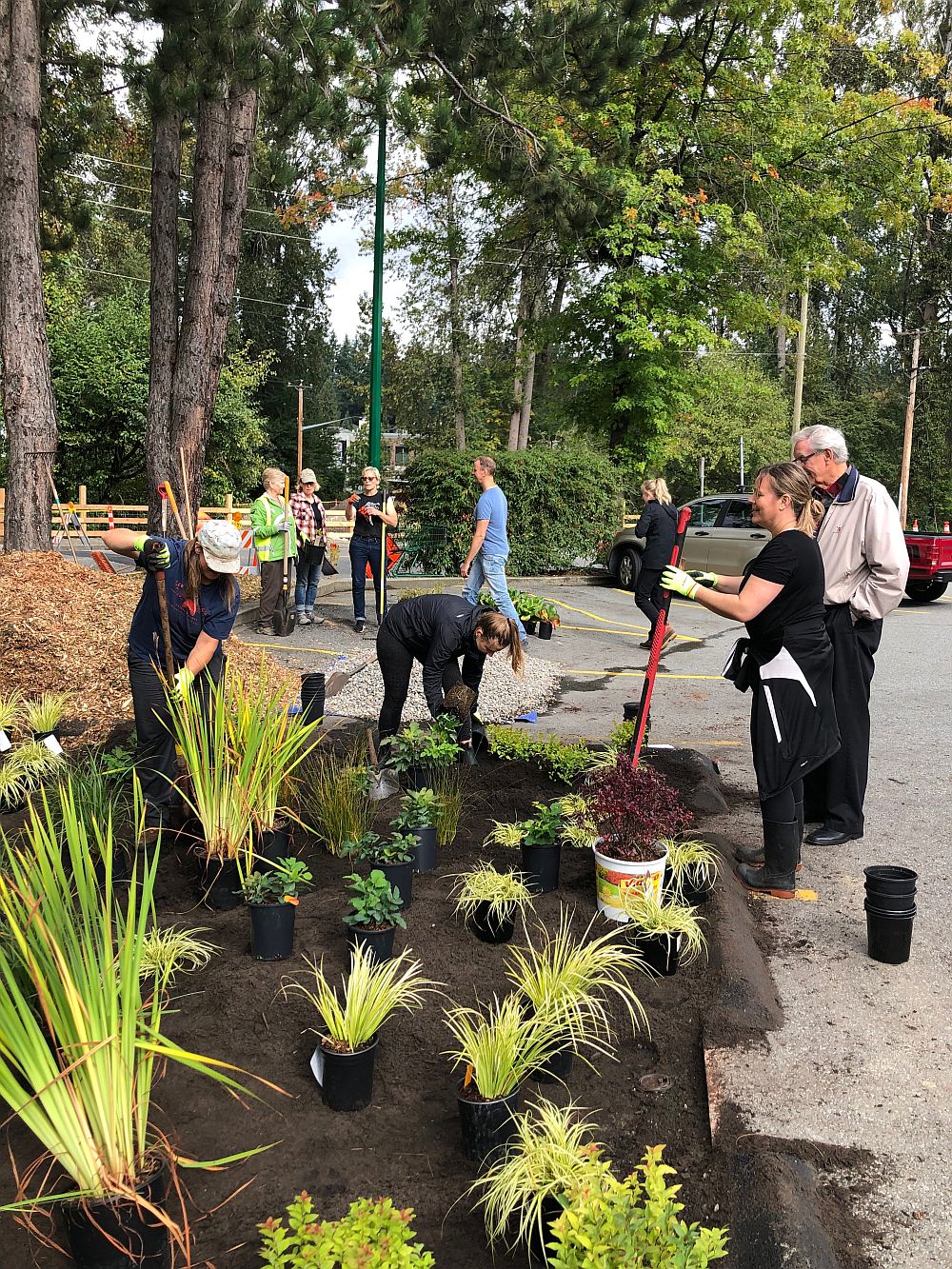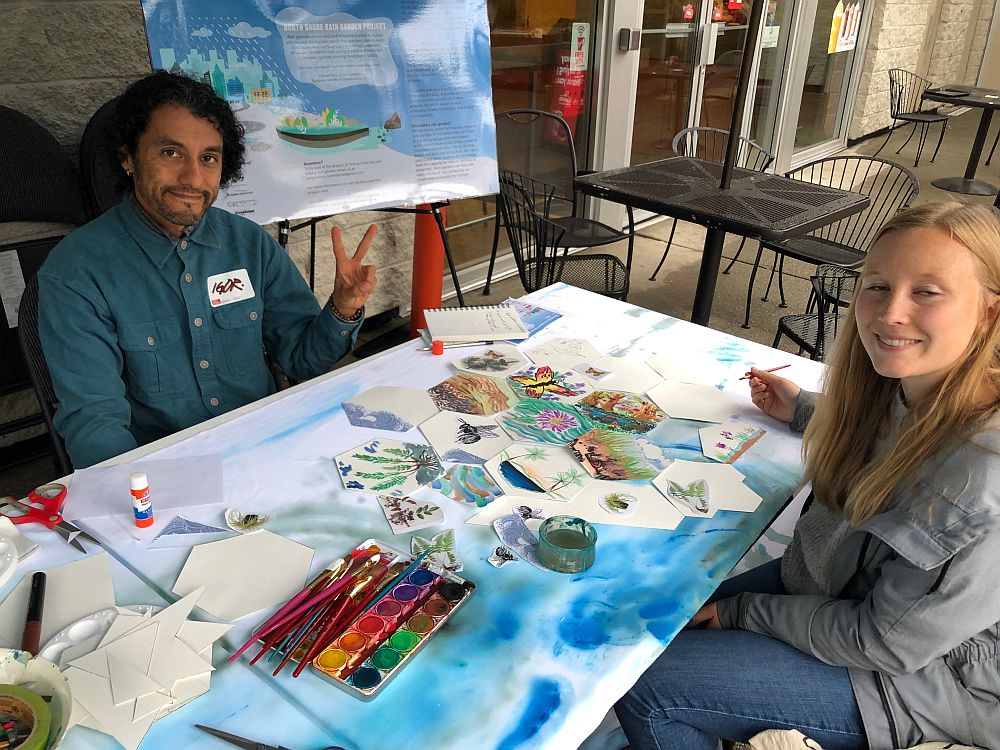BUILDING RAIN GARDENS IN THE CLIMATE EMERGENCY ERA: “We hope that as the broader community learns about the North Shore Rain Garden Project, this awareness will encourage homeowners to take an active role and see the potential for rain gardens in their own backyards,” stated Dr. Joanna Ashworth, Project Director
Note to Reader:
Three municipalities in the Metro Vancouver region are ‘rain garden leaders’, with each having a long history of implementing a rain garden program. In previous years, the Partnership for Water Sustainability has showcased the accomplishments of North Vancouver City, Delta and Langley Township in our Watershed Case Profile Series. In the story that follows, we feature the grass-roots North Shore Rain Garden Project led by Dr. Joanna Ashworth.
A resident of Metro Vancouver’s North Shore sub-region, Joanna Ashworth is Director Professional Programs and Partnerships, and Research Associate with the Pacific Water Research Centre in the Faculty of Environment, at Simon Fraser University. Below, she shares her story, starting with an epiphany in 2016 that launched her rain garden quest. The North Shore Rain Garden Project is a shining example of what can be achieved through personal dedication, sustained commitment and a ‘top-down and bottom-approach’ that brings people together to ‘improve where we live’.
Rain garden is a term that resonates with the public because it is visual and understandable. British Columbia was an early adopter of ‘rain garden’ as a pragmatic alternative to use of technical buzzwords such as bioswale. In 2015, the imperative for use of clear language was formally initiated when Metro Vancouver published guidelines and posters for absorbent landscapes.
In 2014, the Partnership for Water Sustainability published ‘what you need to know’ guidance on how Water Balance performance targets for storage, infiltration and flow release can be easily integrated into a rain garden design to mimic how rainwater reaches a stream naturally, and in so doing reconnect hydrology and ecology. As stated on page 6-1 of Stormwater Planning: A Guidebook for British Columbia, “Performance targets provide the foundation for implementing common sense solutions that eliminate the source of rainwater-related problems.”

North Shore Rain Garden Project in Metro Vancouver
Joanna Ashworth is the visionary leader and Project Director for the North Shore Rain Gardens Project. She is an educator in sustainability, civic engagement and social learning. She has been a leader in community-based research, place-based planning, and democratic methods of teaching and learning.
 “We are grateful to the City of North Vancouver, QuadReal, The Nature Trust of BC , the Western Residents’ Association, Horseshoe Bay Business Association, and North Growth Foundation,” stated Dr. Ashworth.
“We are grateful to the City of North Vancouver, QuadReal, The Nature Trust of BC , the Western Residents’ Association, Horseshoe Bay Business Association, and North Growth Foundation,” stated Dr. Ashworth.
“They are helping us provide a hands-on learning experience that will ultimately increase our capacity as a community to collectively contribute to rainwater management and environmental stewardship, including addressing the larger issue of the impact of the climate crisis.
“We hope that as the broader community learns about this it will encourage homeowners to take an active role and see the potential for rain gardens in their own backyards.”
To Learn More:
For information about the North Shore Rain Garden Project:
https://www.sfu.ca/fenv/programs/professional-programs/community-engaged-research/north-shore-rain-garden-project/

Beginnings: The Ground was Prepared
From Problem to Amenity
“Kyra was unhappy with the muddy mess that was their school’s playground so she and other parents had started a campaign to build a rain garden and bioswale to manage the water flow that was contaminating the school field.
“I went to visit the school soon after and was beyond inspired by the beauty and functionality of the project. More people needed to know about the profound work that nature was doing for this school ground.
“Then I discovered 12,000 Rain Gardens Project and another equally inspiriting leader, ecologist Aaron Clarke, who was working with Washington State University and Stewardship Partners spreading the word and the practice of rain garden technology.”
Making Strides in the Green Infrastructure Space
“The combination of ecological restoration and community engagement in both these initiatives struck me as a powerful partnership. Add to this mix, the power of local government to make institutional changes to their rainwater management plans and the potential for change was enormous. The North Shore of Metro Vancouver counts on three municipal governments, and each of them is making strides in the green infrastructure (GI) space – for example, the former mayor of the City of North Vancouver, Darrell Mussato, is on record saying:
 “Rain gardens have ecological importance and are a standard requirement for all developments in the City of North Vancouver. In addition, all of our major transportation projects incorporate rain gardens. A single rain garden will not make a material difference to conditions in our creeks. But 1000 rain gardens would be a different story. These will take time to implement. The process will be incremental. Before the City’s mindset was out of sight, out of mind. Now we celebrate rain. We have success stories to share. We would like neighbourhoods to get involved in the design of their rain gardens.”
“Rain gardens have ecological importance and are a standard requirement for all developments in the City of North Vancouver. In addition, all of our major transportation projects incorporate rain gardens. A single rain garden will not make a material difference to conditions in our creeks. But 1000 rain gardens would be a different story. These will take time to implement. The process will be incremental. Before the City’s mindset was out of sight, out of mind. Now we celebrate rain. We have success stories to share. We would like neighbourhoods to get involved in the design of their rain gardens.”“True. One rain garden does not seem like much in the face of so much road water runoff that is sending contaminants into our salmon bearing streams and rivers, but scaled up, green infrastructure like rain gardens capture and filter large volumes of runoff, thereby reducing flow and pollutants and better protecting species. These green approaches are also more cost effective than replacing municipal storm water infrastructure; and they provide opportunities for community interaction.
“Local governments in Metro Vancouver and other regions are now beginning to incorporate GI into high level planning documents like Official Community Plans. This is very encouraging.”
Bringing the Rain Garden Vision to Fruition
“After my rain garden epiphany, as the director of professional programs in SFU’s Faculty of Environment, I went to work building connections with the North Shore governments, looking for partners to work with me and to fund this research and community-based work.
“Later in the Fall of 2016, the North Shore Rain Garden Project was launched! Since that time, we would go on to educate community members on the benefits of rain gardens, offer professional development on GI to municipal staff and find resources to design and install two community demonstration rain gardens. One is located in the parking lot of a busy shopping mall and the other is in a residential park. Both rain gardens involved huge community support and participation as well as cooperation by the City of North Vancouver and the District of West Vancouver, and funding from the Nature Trust of BC and North Growth Foundation.
“The North Shore Rain Garden Project (NSRGP) is building the capacity for communities to proactively contribute to rainwater management and community stewardship, and in doing so, they are becoming ‘flood resistant and water resilient’. In 2018, the NSRGP formed a Rain Garden Design Advisory Panel (The Rain Garden Panel) to guide our work.
“Panel members are a diverse group of community-based volunteers with a range of professional skills and experiences including engineering, communications, salmon creek restoration, professional landscape design and installation, ecological restoration, and engagement in the North Vancouver Butterflyways Program.”

Connecting Rain Gardens with Climate Resiliency
Art Practices Engage Citizens
“Prior to the installation of the rain garden, our project set up a table in the Capilano Mall in North Vancouver to engage citizens in conversations about the value and function of rain gardens, highlighting them as a form of green infrastructure.
“Community members were invited to reflect through painting and drawing, how plants, soil and mulch capture runoff from parking lots, driveways and roadways. The art-making activity gave locals a hands-on experience that had them reflecting on the rain garden as a mini natural asset; one that cleans and controls water flows and in doing so improves conditions for species inhabiting the creek like salmon, cutthroat trout, aquatic invertebrates, amphibians and waterfowl. Many joined us on the day of the installation to help out.”
A Look Ahead

Art Practices Engage Citizens


